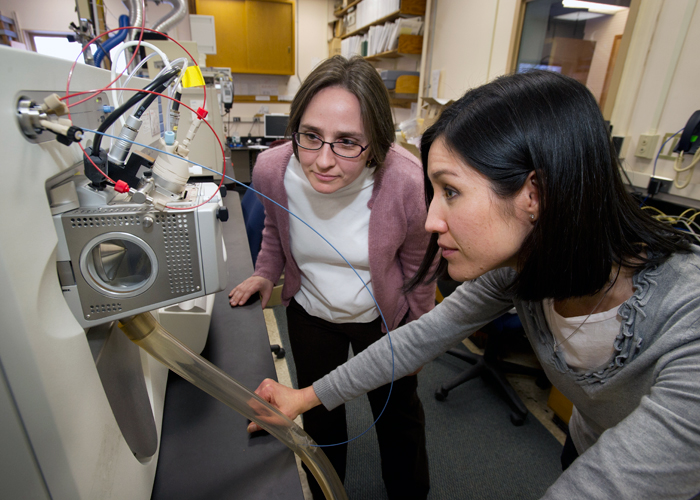Analyzing Gulf Water Samples
Deepwater Horizon, 2010
Principle Investigator: Liz Kujawinski
Oil is a complex mixture of up to 100,000 compounds, some soluble in water, some not. Once it enters the environment, particularly the ocean, it begins to fractionate and no longer acts as a single substance. WHOI chemists have developed finely tuned analytical instruments and techniques to track minute amounts of the soluble components of oil in the Gulf, as well as faint chemical traces of the dispersants used to break up the spill.
WHOI chemist Liz Kujawinski employed a Fourier transform ion cyclotron resonance mass spectrometer (FT-ICR-MS), a device with a magnet seven times stronger than most CT scanners, to make ultra-fine measurements of the chemical components in Gulf water samples. From these, she was able to trace the movement of individual compounds through the water and over time and to look for signs that any of these were changing or degrading.
One of the chemicals Kujawinski and her lab colleagues traced was a component of Corexit, the dispersants used to fight the spill. They found minute amounts present in water samples months after it had been injected at the wellhead. The key question left unanswered now is how, or even if, the sensitive Gulf ecosystem will respond to the myriad chemicals that remained in the environment for months.
From Oceanus Magazine
January 26, 2011
After the Oil Spill, Finding a Drop in the Ocean
WHOI scientists have found that a technique developed for entirely different reasons could readily be adapted to track the chemical components of the oil from the Deepwater Horizon disaster and the dispersant used to try to clean it up.
Source: Oceanus Magazine
Related Multimedia
Science in a Time of Crisis, Chapter 6: Assessing the Impacts
WHOI's Response to the Deepwater Horizon Oil Spill
Related Technology
Fourier-Transform Ion Cyclotron Resonance Mass Spectrometer (FT-ICR-MS)
An ultra-high sensitivity mass spectrometer capable of detecting small quantities of a substance in complex samples and used to measure the fate of dispersants in Gulf waters.



